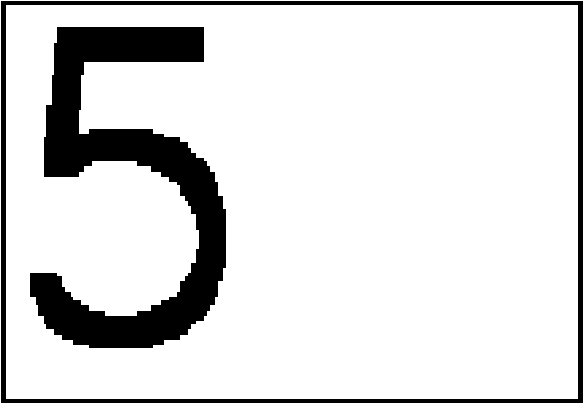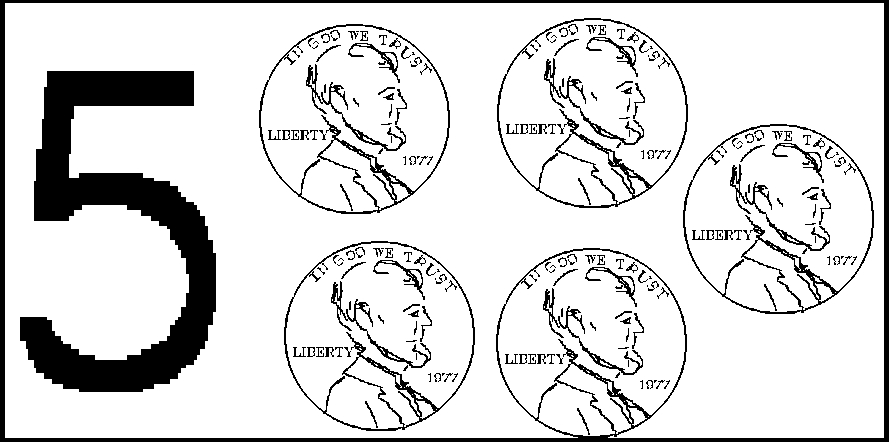MATH GAMES FOR ADULT AND CHILD
SHOW ME WITH COINS
TOPIC and LEVEL: Counting: Advanced; Addition/Subtraction: Advanced
PLAY AFTER: HOW MANY WOULD YOU LIKE?, WAR, and COUNTING BY PLAY WITH: STONES ON MY LEGS, COUNTING BY, WAR, WHAT WOULD YOU LIKE TO BUY?
Key Instructions and Questions:

- A penny and nickel have been placed on a sheet of paper which has been labeled as shown.
- Show me how to fill this box with money worth 5 pennies.
- Can you show me five cents without giving me a nickel?
- Show me two different collections of coins each worth 6 cents.
- Show me seven cents.
- Show me ten cents.
- Show me twenty-six cents.
- Tell me how much money I have here.
- Show me what's left when I have 5 cents and I spend 2 cents.
- Show me the change if I buy ten cents worth of candy with 25 cents.
- How much money will you have if I give you 2 dimes, 3 nickels, and 1 penny?
Counting money should be learned in the home, not in the school. Learning to count money is logically a continuation of the process of learning to count other things. The presence of the thing is important at initial and early exposure. Coins are not manipulatives considered appropriate for classroom use. Give your child substantial experience in handling, stacking, playing with, and counting money before the topic is discussed in school.
Before using coins as pieces having different value, it is important to establish the idea that one thing may have more or less value than one other thing. This is not an easy concept. If your child does not understand this idea, do not play SHOW ME WITH COINS.
With a young child, I suggest working with only nickels and pennies at first. With an older child, one might try more coins. Playing COUNTING BY FIVES or COUNTING BY TENS also provides good background activity prior to work with coins, but this is not absolutely necessary.
Work with coins is difficult for the young child. Caution should be taken not to rush the issue--not to play with coins to soon. Here we will examine two different approaches to SHOW ME WITH COINS as played with a young child. The first way is a more academic, less play-oriented, approach. You may wish to explore both ways.

A penny and a nickel have been placed on a sheet of paper which has been labeled as shown at the left. If your child or children do not know the symbols "1" and "5", the game WAR might be played before and with SHOW ME WITH COINS.
Also on hand is a pile of coins containing both pennies and nickels.

The Adult requests, "Show me how to fill this box with money worth five pennies," and draws the picture at the right .
The Child picks a nickel from the pile and places it in the rectangle.

"Good," remarks the Adult, "now fill this," drawing the figure below.

"Good."

The Adult next draws different rectangles one which can enclose exactly 6 pennies and the other which can enclose exactly two coins--a penny and a rectangle, then asks the Child to fill the rectangles with money worth 6 cents.
This variation of the game is good because the child's can see that more than one way of having six cents is possible.
The second variation of the game of SHOW ME WITH COINS is a less academic way of achieving the same results.
Here are the kinds of questions which might be asked.
"Show me five cents."
"Can you show me five cents without giving me a nickel?"
"Can you show me two different collections of coins each worth 6 cents?"
"Could you use a nickel to make a pile with 6 cents."
At first, when playing the game of SHOW ME, the Adult will, of necessity, be the requester. Role reversal is not as important in the beginning of this game as in HOW MANY WOULD YOU LIKE?, but role reversal should occur when possible.
As the child becomes more proficient, questions will gradually change from:
"Show me seven cents," and
"Show me ten cents," and
"Show me twenty-six cents," and
"Please give me smaller coins for this quarter," and
"Tell me how much money I have here," and
"Tell me how much money you'll have if I give you one dime and two pennies," to:
"Show me what's left when I have five cents and spend two cents," and "Show me the change if I buy ten cents worth of candy with twenty¬five cents," and "Give me change for a dollar," and "Tell me how much money you'll have if I give you two dimes,three nickels, and one penny." Playing SHOW ME uses concrete objects to help build skills used in STONES ON MY LEGS and addition and subtraction without concrete objects or mental images. Each time you play these games, ask questions the child's heard before, spend time with questions of the child's current level of sophistication, and reach a bit beyond what you think the child can answer. You maybe pleasantly surprised. If your child does become a proficient money handler or computer, try the HUNDRED BOARD advanced play version of BINGO, the one dealing with money. This game is not for the ordinary child, but, your child may not be ordinary!
